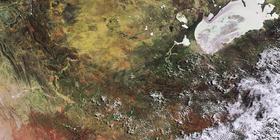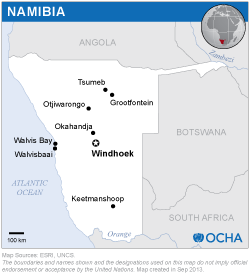The mission included experts from JRC, DLR, GTZ, ITC, NASA, NOAA, USRI, UNESCO, WMO and was coordinated by UN-SPIDER.
The mission included:
- A field trip to the Northeastern Caprivi region and the central Cuvelai-Drainage System in Northern Namibia close to the border of Angola, which were affected by floods. The field trip included comprehensive photo documentation and GPS measurements of roads and particular geographic locations; as well as discussions with stakeholders from regional councils and relief organisations (police, fire brigade, national defense forces) to document measures and mechanism of emergency and crisis management and other relevant experiences.
- A technical workshop organized by the Namibian Ministry of Agriculture Water and Forestry. The goal of the workshop was to identify and discuss lessons-learned from the Namibian disaster management institutions and national and regional relief practitioners and to provide technical expert knowledge regarding the use of space technology to better facilitate international collaboration in the future.
- A high-level debriefing to high-level authorities including the Minister for Agriculture, Water and Forestry, the Under Secretary of the Department of Water Affairs and Forestry, the UN Resident Coordinator in Namibia, and the Ambassador of the United States of America to Namibia.
The mission allowed experts to increase their awareness regarding the floods that have impacted Namibia in recent years and ways in which emergency response efforts are carried out at the national and local levels.
The mission took note of the existing basic capacity in several institutions in Namibia to work with space-based information and technology such as GPS and imagery. The mission team also identified that the flow of disaster-relevant information among different government institutions is still insufficient or even non-existing. This actually hinders the effective use of existing spatial and space-based information, especially as disaster relevant applications typically require information from different sectors of the administration.


